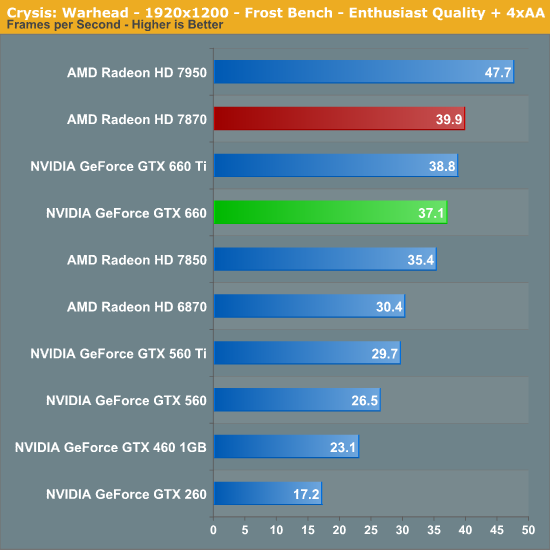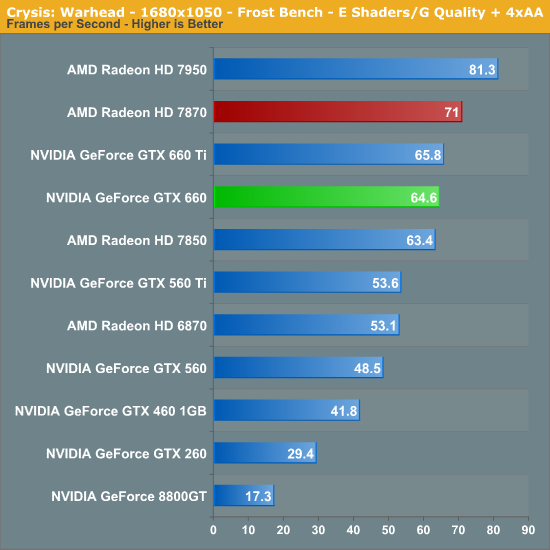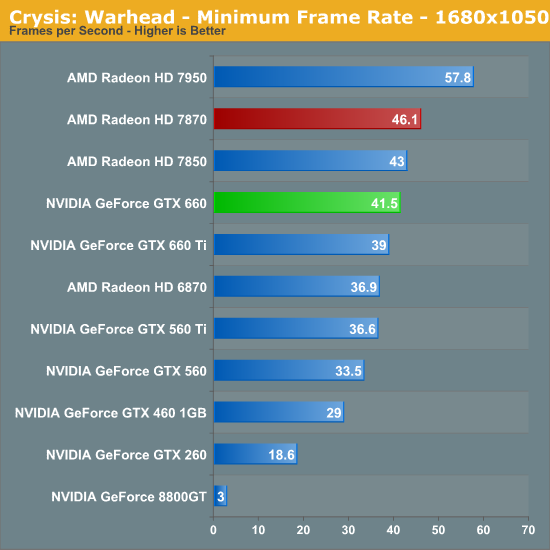The NVIDIA GeForce GTX 660 Review: GK106 Fills Out The Kepler Family
by Ryan Smith on September 13, 2012 9:00 AM ESTCrysis: Warhead
Kicking things off as always is Crysis: Warhead. It’s no longer the toughest game in our benchmark suite, but it’s still a technically complex game that has proven to be a very consistent benchmark. Thus even four years since the release of the original Crysis, “but can it run Crysis?” is still an important question, and the answer continues to be “no.” While we’re closer than ever, full Enthusiast settings at a 60fps is still beyond the grasp of a single-GPU card.


Crysis has been a game that has consistently penalized Kepler for its lack of memory bandwidth. Nowhere was this more evident than the GTX 660 Ti, which thanks to its memory bus reduction took a significant hit. But as we alluded to in our introduction, there’s a corner case where the GTX 660 is going to be able to easily keep up with the GTX 660 Ti: ROP and memory bandwidth-bound situations. As a result we’re looking at the best case scenario for the GTX 660 when held up against the GTX 660 Ti, which sees the GTX 660 offer 95% of the performance of the GTX 660 Ti. Most games aren’t going to be like this, but in this one case the GTX 660 may as well be as good as the GTX 660 Ti as far as performance goes, which goes to prove just how bottlenecked Crysis is by memory bandwidth.
Looking at a more meaningful comparison, because the GTX 660 doesn’t take a memory bandwidth hit compared to the GTX 660 Ti, the resulting card is much more resource balanced which in turn impacts AMD’s ability to lead in this benchmark. AMD once again wins here with the 7870 taking the lead, but only by a relatively modest 7% margin. This is the first time we haven’t seen a comparable AMD card lead by a significant margin in this generation, which for NVIDIA is an improvement though still not a reversal of fortunes. At the same time however NVIDIA isn’t doing too much better than the 7850 here, beating AMD’s lesser 7800 by an even more modest 5%.
As for NVIDIA’s older cards, the generational performance gains are in-line with what we’ve already seen out of the other GTX 600 cards. Compared to the GTX 460 1GB for example, a card that launched over 2 years ago at the same price, performance is up by 50-60%. But unsurprisingly this is less than the performance gain going from the 8800GT to the GTX 460, a similar timeline jump that saw performance more than double. At the very least NVIDIA certainly has the 8800GT licked at this point (by nearly a factor of 4x), but this means they’re also at risk of perpetuating longer upgrade cycles for current GTX 460 owners.


Moving on to minimum framerates, our results are almost the same with one interesting twist: the GTX 660 is now beating the more expensive GTX 660 Ti. Why? As we mentioned earlier, because of the higher core clock the ROPs on the GTX 660 actually have a greater theoretical throughput than the ROPs on the GTX 660 Ti. Since we’re not seeing any other factors that would explain this difference (i.e. drivers) it’s very likely that the GTX 660’s faster ROPs are giving it the advantage here.
Though while this is enough to push the GTX 660 ahead of the GTX 660 Ti, it’s not improving the GTX 660’s situation relative to the 7800 series at all. The GTX 660 is still closer to the 7850 than it is the 7870 here.










147 Comments
View All Comments
Galidou - Thursday, September 20, 2012 - link
Whenever I see CeriseCogburn commenting, Chizow is not, and vice versa....If you never heard about price fixing, sorry for you but it's a fact, THAT is a fact, people don't have to beleive in that, it's happening right now and always has been and beleive me it will continue, because almost every company in the world is greedy even if it means communicating with the competition to maximize profit....
CeriseCogburn - Thursday, November 29, 2012 - link
Gal, you silly gal, Chizow knows a lot more than I do, but I'll say this, you're an insane and incorrect amd fanboy of the worst kind.I hope david's butt remains a delicacy to you, even after the corpse is buried, which is, by the way, to happen, very soon.
CeriseCogburn - Thursday, November 29, 2012 - link
Galidou, you win NOTHING for being a lying sack, then whining when someone is so sick of your complete bs, they offend your idiot retarded estrogen doused amd licking being because they aren't a sick lying gasbag biased amd pig.Glad that religious Bible story has you kissing david amd's tokus furiously though, as that surely commands respect.
LOL
NOT !
Oh, were you insulted ?
Let's hope so, because of course, you tell so many lies, it's IMPOSSIBLE for you to not be insulted.
rarson - Tuesday, September 18, 2012 - link
AMD's pricing doesn't need to be defended because anyone with a grasp of basic economics can easily understand why they priced them the way they did. That's why most people are ignoring your inane and mind-bogglingly stupid comments."How do you feel now about those $550, $450, and $350 pricepoints you so vigorously defended when the 7970/7950/7870 launched?"
Absolutely fine, dumbass, because it's September now. Duh.
"So just as I asked then"
Nobody cares, dude. Go fanboy somewhere else.
chizow - Tuesday, September 18, 2012 - link
Yes anyone with a basic grasp of economics would never have defended the worst increase in price and performance in the last decade and then be OK with the biggest price drop in the least amount of time within the same generation. AMD now holds the notorious distinction for both and their fanboys (like you) get to suffer the consequences.How much did the GTX 580 cost 15 months after release? $500 still dumbass, duh, now go fanboy somewhere else? Parts like this don't lose their value unless they suck, or their pricing sucks, or both, but obviously you're too oblivious or stupid to realize this, or maybe you're just accustomed to it as an AMD fan.
CeriseCogburn - Thursday, November 29, 2012 - link
You're an idiot.AMD cost me plenty, and I will NEVER fall for your stupid amd lies, ever again.
Klimax - Saturday, September 15, 2012 - link
A thing: Dirt Showdown is AMD game using DC codepath optimised ONLY for Radeons severly penalising nVidia's cards. It is not valid for any comparsions.(At least not with that option enabled)
chizow - Thursday, September 13, 2012 - link
Just wondered if there was any news about price drops for higher-end SKUs. It becomes more obvious with every newly released SKU that the original asking prices from both AMD and Nvidia on 28nm parts were far too high. $350 for a 7870 looks like a complete debacle at this point given a $229 part outperforms it just a few months later.Also it looks like the Summer 2012 GPU pricing chart needs to be adjusted for the GTX 660 (it shows $239).
Thanks for the commentary on page 3 about Nvidia's Competition. Much like Intel, they still need to compete with themselves to entice owners of their previous products to upgrade. I'm glad someone else gets it, its pretty obvious Nvidia does as well. I guess they heard the complaints of all their enthusiasts when asking $500 flagship dollars for a part based on a midrange ASIC.
RussianSensation - Thursday, September 13, 2012 - link
A couple months?HD7850 - $249 March 3, 2012
HD7870 - $349 March 3, 2012
GTX660 - $229 September 13, 2012
It's been 7 months.
Someone who bought an HD7850 and OCed it enjoyed ~ GTX580 / HD7950 level of performance for 7 months now. Using the same exact logic you have just outlined, then we should recommend people to wait 7 more months for HD8000 series and skip GTX660 because for them the 660 would be an "early adopter" premium vs. HD8870. See how illogical your comment is?
GPUs often drop in price over time as the generation goes on.
Interesting how GTX280 for $649 and GTX260 $399 weren't a problem for you.
chizow - Thursday, September 13, 2012 - link
Except we've already covered this pricing debacle months ago, pretty sure you were onboard then, what happened since then?The 7870 was already vastly overpriced because it offered 6970/GTX 570 at.....6970 and GTX 570 prices. Parts that were already widely available for at least 20 months prior to the 7870's launch at the exact same prices. Anyone who already had that performance level would have no incentive to sidegrade to a 7870 at that pricepoint.
What is obvious now as it was then is that there was no movement in terms of price:performance that you would expect from a new generation, the metric didn't shift at all for 28nm until Kepler launched. Now that Kepler has finally trickled down to this performance level, its that much more clear. Bringing your 8870 argument into the fold, I wouldn't agree with that view either as I would expect the 8870 to offer more performance at a lower pricepoint, not the same performance at the same price as is the case with the 7870 at launch.
I don't know why you're trying to defend AMD's horrid 28nm pricing but the fact of the matter is, the current pricing structure is really what 28nm should have been from the outset, anyone who bought in March and didn't actually need a new GPU is undoubtedly feeling the burn of all the recent price drops, but hey, at least its not as bad as Facebook's IPO?
And no, GTX 260/280 weren't a problem for me because the difference is with those parts, the performance justified the premium relative to the last generation of cards (8800GT/GTX). This generation clearly does not adhere to those same expectations, which again, is a view I'm pretty sure you were onboard with months ago. What Nvidia didn't expect was for AMD to lowball them so much on a certain performance level, something AMD has clearly worked to remedy with each successive generation with their increases in asking prices for their 1st and 2nd tier single-GPU SKUs.